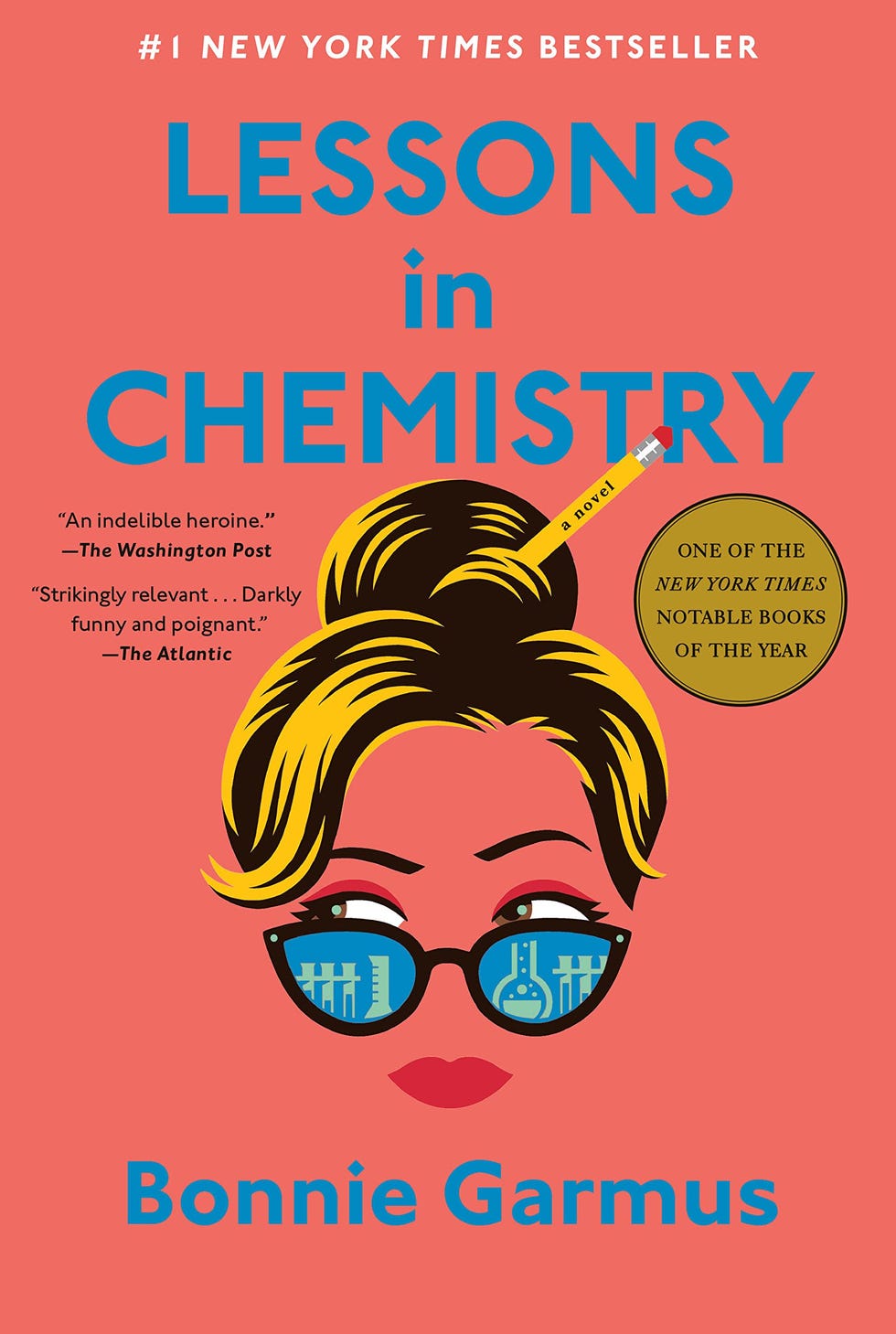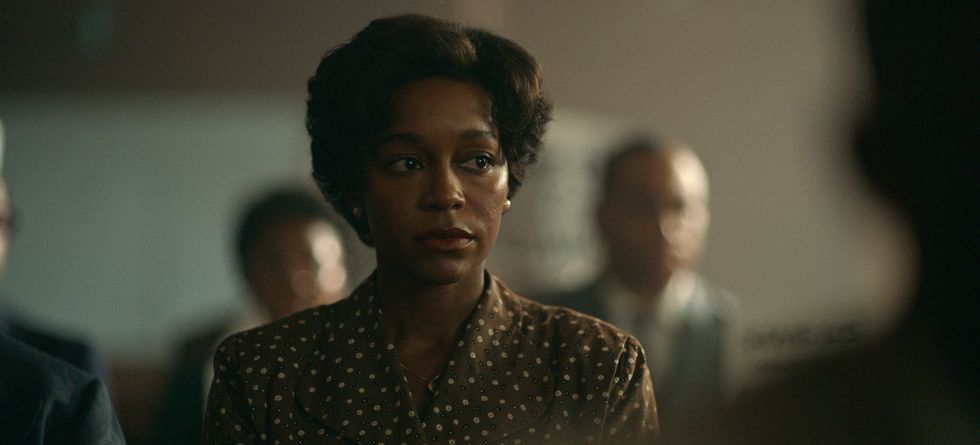How Does the Lessons in Chemistry Series Compare to the Book?
Spoilers below.
I know by now not to judge a book by its cover, but diving into Lessons in Chemistry still surprised me after flipping past its bubblegum pink cover and playful design. Set in the 1950s, Bonnie Garmus’ wildly popular debut novel follows protagonist Elizabeth Zott, a lab tech at the prestigious Hastings Research Institute. Her lack of a Ph.D. means she cannot get the respect she deserves—her all-male team treats her like a glorified maid—and rampant sexism is far from the only challenge. Amid a sequence of traumatic events, Elizabeth’s dark tale is also one of resilience, love, community, and career. Can the limited series adaptation of the book capture the richness of the source material?
More From ELLE

The short answer is yes, and then some. As with any book-to-screen journey, there are notable differences that take a TV audience into account. Lee Eisenberg’s Apple TV+ series, starring and produced by Brie Larson, follows the recipe but isn’t afraid to make some substitutions for a more substantial final dish. That’s particularly true of some supporting characters and the finer details of Elizabeth’s journey from lab tech to reluctant host of TV cooking sensation Supper at Six. However, there are some bumps in the road, and a particularly unusual perspective could be divisive—or at least distracting.
Just as theLessons in Chemistry book cover is deceptive in its eye-catching flirty illustration, Elizabeth’s television series is a trojan horse. Supper at Six presents itself as a cooking show for housewives to brush up on their skills in the kitchen, but it also offers tools of empowerment that cannot be found in a recipe book. Still, ambition and romance can co-exist, and neither takes a backseat, in the Apple TV+ period drama as brilliant scientist Dr. Calvin Evans (Lewis Pullman) is the fiery catalyst that ultimately puts Elizabeth on a path to TV stardom out of financial necessity. Below, we break down some of the biggest differences between Bonnie Garmus’ bestselling novel and the series. Check back weekly for updates as new episodes drop.
The Love Story
Elizabeth and Calvin’s courtship starts on a fiery note.
Enemies-to-lovers is a tried and tested formula, which both Garmus and Eisenberg understand. In the novel, Elizabeth takes beakers from Calvin’s personal lab and immediately engages in a war of words with him. The show adds subterfuge to this incident as she sneakily takes a bottle of ribose for her after-hours research. Unfortunately, Elizabeth doesn’t realize ultimate busybody Fran Frask (Stephanie Koenig) spots and is not afraid to tattle. Book readers will know Calvin assumes Elizabeth is a secretary, as the notion of a female chemist is unheard of to every man who works in this building, which unsurprisingly does not go down well.
To up the stakes, Elizabeth is practically forced to participate in a cringe-inducing Little Miss Hasting pageant under the guise of being a good team player. This work social replaces a performance of the Mikado from the book as the venue for the great vomit incident. In doing so, it highlights how both are loners within the Hastings employees. Like the novel, Calvin’s sickness is triggered by perfume, and a humiliated Elizabeth exits the competition early. When he inadvertently pukes all over Elizabeth’s back, it allows the mortified Calvin to reintroduce himself and apologize for his previous error.
The first kiss location is changed.
At first, their relationship remains professional, and the series expands on how Elizabeth’s past trauma makes it hard for her to feel safe—particularly in a room with a shut door. Trust comes from open communication, and an offer to teach Elizabeth how to row becomes part of this process. Whereas in the book, they are already a couple when Calvin takes her out on the water, in the show, it is where they first kiss (instead of the Hastings parking lot). Both versions have Elizabeth initiating the smooch, and Larson and Pulman’s chemistry is off the charts.
In this era, it is taboo for an unmarried couple to move in together, and Calvin’s public proposal in the cafeteria is skipped for something more intimate. Removing the Greek chorus heightens the swoon-worthy festive sequence when Calvin prepares a private feast with Elizabeth and suggests cohabiting. True to the book, the house is paid for (thanks to Calvin’s successful career), so her incredible cooking will suffice. Elizabeth takes food incredibly seriously: It is an act of love and a method of working through setbacks in her life—which will happen sooner rather than later.
Calvin’s fateful run is slightly different.
The second episode, “Her and Him,” is a cold slap in the face. Yep, Calvin just got hit by a bus, and this isn’t a Regina George in Mean Girls situation. Book fans will no doubt have been on edge as soon as Calvin grabbed the dog’s new leash before heading for a run, and what follows is similar—but not the same—to his demise in the novel.
Calvin is an exercise outlier, as jogging or running didn’t become popular until the ’70s. In the novel, Calvin used to run with their pet dog, Six-Thirty, without a leash, and Elizabeth purchased one due to new leash laws. Eisenberg does away with this legal aspect, and here the leash is used so the canine can be Calvin’s new running buddy.
Unfortunately, a game of tug of war occurs while Calvin stands on the road, and he falls back with the leash at the exact wrong moment. If anyone was looking for foreshadowing, the alarm bells should start ringing when Calvin starts talking about the unpredictability of life. In the book, Calvin is run over by a police car after he has slipped on oil and hit his head. He falls after the engine has backfired, causing Six-Thrity to bolt while leashed. Whereas this involves an almost-comedic Rube Goldberg machine level of events, there is horrifying simplicity to the bus coming out of nowhere.
The Characters
Harriet Sloane gets a major overhaul.
Of all the changes from the source material, the most notable is to Calvin’s neighbor, Harriet Sloane (Aja Naomi King), who in the book is a middle-aged Catholic white woman with an abusive husband. Rather than simply flip a white character for a Black one, the TV series has rewritten everything about Harriet beyond her name and neighbor status. Harriet has two young children and is similar in age to Elizabeth. Her husband currently serves as a military surgeon in the Korean War, and Calvin is on hand to babysit when needed. Dating this friendship to pre-Elizabeth further fleshes out Calvin and Harriet’s bond.
Harriet’s family, relationships, and age are far from the only alterations. She is an ambitious woman who actively tries to save her community using her legal aid expertise. Plans to expand the freeway threaten this neighborhood, and this storyline is based on historical racist infrastructure practices in states like California. This drastic page-to-screen shift before Harriet and Elizabeth meet is impactful because it shows this character isn’t simply there to serve her neighbor—though this friendship is integral to the series.
In fact, Calvin lets Harriet down in the second episode when he forgets to attend an important meeting about the freeway plans. Harriet knows he holds power as a white man, and his fame as an accomplished scientist is worth its weight in gold to their cause. Instead, Calvin is preoccupied with his burgeoning relationship and work with Elizabeth. Adding this element underscores the myriad ways Black communities are targeted during this time and that, as an ally, words only mean so much when a person doesn’t follow through.
The Hastings co-workers are still awful.
Whereas this Harriet storyline is a show invention, Calvin’s attempts to help Elizabeth bypass sexism at work match the text. She faces misogyny from all sides, and Fran Frask’s know-it-all demeanor closely follows the book. Fran can’t wait to put Elizabeth in her place, which is an ugly side of the supposedly forward-thinking scientific institution. Fran’s fury about Elizabeth skipping out on the pageant further hammers home her antagonistic role early on. The men at Hastings, like Dr. Donatti (Derek Cecil), think Calvin is arrogant and has little time for Elizabeth (even though they often turn to her for work advice). This hostile environment matches the novel’s description.
Elizabeth’s Career
Elizabeth’s tragic Ph.D backstory is the same.
Elizabeth’s lack of a Ph.D. is a constant criticism, and in the first episode, she doesn’t get into specifics regarding her unfinished academic record. Again, this is similar to the book, as is what really happened to her, and the series changes what point on Elizabeth’s academic timeline it happens—though in both cases it derails her progress. The second episode opens with a trigger warning, revealing why she hasn’t got her Ph.D. as a tenured professor raped her. Elizabeth used the pencil in her hair to fend off her attacker, stabbing him and getting reprimanded for her actions. In the novel, a UCLA campus cop doesn’t buy her story, and in the series, she is told she can only complete her candidacy if she submits a “formal statement of regret.” She rightly cannot abide saying sorry to the man who raped her, and as far as academia is concerned, she only has her Masters degree. In both the book and show, Elizabeth regrets “not having more pencils,” and this scene speaks to the horrifying obstacles in her career.
This story will be updated.

Emma Fraser is a freelance culture writer with a focus on TV, movies, and costume design. You can find her talking about all of these things on Twitter.




